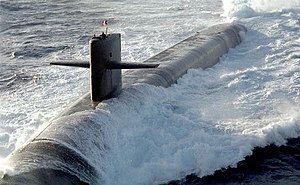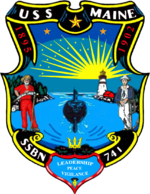USS Maine (SSBN-741)
 USS Maine (SSBN-741) in the Caribbean Sea approximately 50 nautical miles (93 kilometers) due south of Naval Station Roosevelt Roads, Puerto Rico.
| |
| History | |
|---|---|
| Namesake | The U.S. state of Maine |
| Ordered | 5 October 1988 |
| Builder | General Dynamics Electric Boat |
| Laid down | 3 July 1990 |
| Launched | 16 July 1994 |
| Commissioned | 29 July 1995 |
| Homeport | Bangor, Washington |
| Motto | Leadership, Peace, Vigilance |
| Status | in active service |
| Badge |  |
| General characteristics | |
| Class and type | Ohio-class ballistic missile submarine |
| Displacement | |
| Length | 560 ft (170 m) |
| Beam | 42 ft (13 m)[1] |
| Draft | 38 ft (12 m) |
| Propulsion | |
| Speed | Greater than 25 knots (46 km/h; 29 mph)[5] |
| Test depth | Greater than 800 feet (240 m)[5] |
| Complement | |
| Armament |
|
USS Maine (SSBN-741) is a United States Navy Ohio-class ballistic missile submarine in commission since 1995. She is the fourth U.S. Navy ship authorized, and the third commissioned, to be named in honor of the state of Maine. She has the capability to carry 24 nuclear armed Trident ballistic missiles.
Construction and commissioning[edit]
The contract to build Maine was awarded to the Electric Boat Division of the General Dynamics Corporation, Groton, Connecticut, on 5 October 1988, and her keel was laid there on 3 July 1990. Maine was launched on 16 July 1994, delivered to the U.S. Navy on 23 June 1995, and commissioned on 29 July 1995 at the Portsmouth Navy Yard, on the shore of its namesake state.
Service history[edit]
Maine has been homeported at Naval Base Kitsap, Bangor, Washington since December 2005. Prior to this, she was homeported at Naval Submarine Base Kings Bay from August 1995 until December 2005.
Maine in fiction[edit]
- Maine plays a major role in Tom Clancy's novel The Sum of All Fears.
References[edit]
- This article includes information collected from the Naval Vessel Register, which, as a U.S. government publication, is in the public domain. The entry can be found here.
- ^ a b c d e f g h "SSBN-726 Ohio-Class FBM Submarines". Federation of American Scientists. 9 February 2000. Retrieved 25 October 2021.
- ^ a b c Frost, Peter. "Newport News contract awarded". Daily Press. Archived from the original on 27 April 2009. Retrieved 27 September 2011.
- ^ "US study of reactor and fuel types to enable naval reactors to shift from HEU fuel". Fissile Materials. 10 April 2020. Retrieved 25 October 2021.
- ^ Brendan Patrick Hanlon (July 2015). Validation of the Use of Low Enriched Uranium as a Replacement for Highly Enriched Uranium in US Submarine Reactors (PDF) (Master thesis). Massachusetts Institute of Technology. Retrieved 25 October 2021.
- ^ a b "Submarine Frequently Asked Questions". Chief of Naval Operations Submarine Warfare Division. Archived from the original on 13 July 2013. Retrieved 27 September 2011.
External links[edit]
- NavSource Online: Submarine Photo Archive Maine (SSBN-741), retrieved 30 September 2011
- Official site, archived from the original on 7 November 2011
